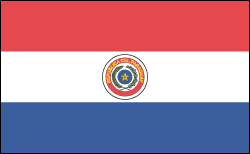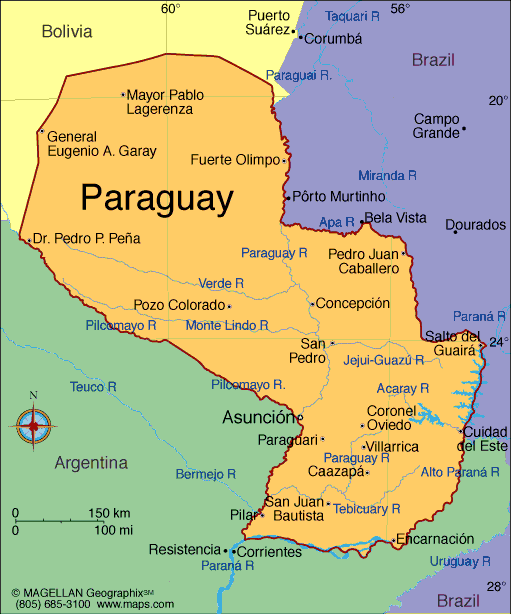PARAGUAY

Geography: California-size Paraguay is surrounded by Brazil, Bolivia, and Argentina in south-central South America. Eastern Paraguay, between the Paraná and Paraguay rivers, is upland country with the thickest population settled on the grassy slope that inclines toward the Paraguay River. The greater part of the Chaco region to the west is covered with marshes, lagoons, dense forests, and jungles.
Government: Constitutional republic.
History: Indians speaking Guaraní—the most common language in Paraguay today, after Spanish—were the country's first inhabitants. In 1526 and again in 1529, Sebastian Cabot explored Paraguay when he sailed up the Paraná and Paraguay rivers. From 1608 until their expulsion from the Spanish dominions in 1767, the Jesuits maintained an extensive establishment in the south and east of Paraguay. In 1811, Paraguay revolted against Spanish rule and became a nominal republic under two consuls.
Paraguay was governed by three dictators during the first 60 years of independence. The third, Francisco López, waged war against Uruguay, Brazil, and Argentina in 1865–1870, a conflict in which half the male population was killed. A new constitution in 1870, designed to prevent dictatorships and internal strife, failed to do so, and not until 1912 did a period of comparative economic and political stability begin. The Chaco War (1932–1935) with Bolivia won Paraguay more western territory.
After World War II, politics became particularly unstable. Alfredo Stroessner was dictator from 1954 until 1989, during which he was accused of the torture and murder of thousands of political opponents. Despite Paraguay's human rights record, the U.S. continuously supported Stroessner.
Stroessner was overthrown by army leader Gen. Andres Rodriguez in 1989. Rodriguez went on to win Paraguay's first multicandidate election in decades. Paraguay's new constitution went into effect in 1992. In 1993, Juan Carlos Wasmosy, a wealthy businessman and the candidate of the governing Colorado Party, won a five-year term in free elections.
Raúl Cubas Grau was elected president in May 1998. In 1999, Cubas was forced from office for his alleged involvement in the assassination of Vice President Luis María Argaña. The vice president had criticized Cubas for refusing to jail his mentor, Gen. Lino Oviedo, who had been convicted of leading a failed 1996 coup against Wasmosy. Oviedo was finally arrested in 2004 and jailed.
Luis Ángel González Macchi, appointed caretaker president after Cubas stepped down, was accused of mishandling $16 million in state funds, and in 2006 he was sentenced to six years in prison. Former journalist Nicanor Duarte Frutos became president on Aug. 15, 2003. He has pledged to clean up the pervasive corruption in his nearly bankrupt country. Paraguay has been in a protracted recession since the late 1990s.
On April 22, 2008, Fernando Lugo, a former Roman Catholic Bishop, was elected president of Paraguay beating the Colorado Party's candidate, Blanca Ovelar de Duarte, by 10 percentage points. Lugo's victory ended the Colorado Party's 61 years in power—a system of bureaucracy and patronage founded in 1887. Fernando Lugo was sworn in as president on Aug. 15, 2008.
Government: Constitutional republic.
History: Indians speaking Guaraní—the most common language in Paraguay today, after Spanish—were the country's first inhabitants. In 1526 and again in 1529, Sebastian Cabot explored Paraguay when he sailed up the Paraná and Paraguay rivers. From 1608 until their expulsion from the Spanish dominions in 1767, the Jesuits maintained an extensive establishment in the south and east of Paraguay. In 1811, Paraguay revolted against Spanish rule and became a nominal republic under two consuls.
Paraguay was governed by three dictators during the first 60 years of independence. The third, Francisco López, waged war against Uruguay, Brazil, and Argentina in 1865–1870, a conflict in which half the male population was killed. A new constitution in 1870, designed to prevent dictatorships and internal strife, failed to do so, and not until 1912 did a period of comparative economic and political stability begin. The Chaco War (1932–1935) with Bolivia won Paraguay more western territory.
After World War II, politics became particularly unstable. Alfredo Stroessner was dictator from 1954 until 1989, during which he was accused of the torture and murder of thousands of political opponents. Despite Paraguay's human rights record, the U.S. continuously supported Stroessner.
Stroessner was overthrown by army leader Gen. Andres Rodriguez in 1989. Rodriguez went on to win Paraguay's first multicandidate election in decades. Paraguay's new constitution went into effect in 1992. In 1993, Juan Carlos Wasmosy, a wealthy businessman and the candidate of the governing Colorado Party, won a five-year term in free elections.
Raúl Cubas Grau was elected president in May 1998. In 1999, Cubas was forced from office for his alleged involvement in the assassination of Vice President Luis María Argaña. The vice president had criticized Cubas for refusing to jail his mentor, Gen. Lino Oviedo, who had been convicted of leading a failed 1996 coup against Wasmosy. Oviedo was finally arrested in 2004 and jailed.
Luis Ángel González Macchi, appointed caretaker president after Cubas stepped down, was accused of mishandling $16 million in state funds, and in 2006 he was sentenced to six years in prison. Former journalist Nicanor Duarte Frutos became president on Aug. 15, 2003. He has pledged to clean up the pervasive corruption in his nearly bankrupt country. Paraguay has been in a protracted recession since the late 1990s.
On April 22, 2008, Fernando Lugo, a former Roman Catholic Bishop, was elected president of Paraguay beating the Colorado Party's candidate, Blanca Ovelar de Duarte, by 10 percentage points. Lugo's victory ended the Colorado Party's 61 years in power—a system of bureaucracy and patronage founded in 1887. Fernando Lugo was sworn in as president on Aug. 15, 2008.

Map of Paraguay
Land area: 153,398 sq mi (397,301 sq km);
total area: 157,046 sq mi (406,750 sq km)
Population (2014 est.): 6,703,860
(growth rate: 1.19%); birth rate: 16.66/1000; infant mortality rate:
20.75/1000; life expectancy: 76.8; density per sq mi: 39
Capital and largest city (2011 est.):
Asunción, 2.139 million
Other large cities: Ciudad del
Este, 320,782; San Lorenzo, 271,064
Monetary unit: Guaraní
National name: República del
Paraguay
Languages:
Spanish, Guaraní (both official)
Ethnicity/race:
mestizo 95%, other 5%
Religions:
Roman Catholic 89.6%, Protestant 6.2%, other Christian 1.1%, other 1.9%, none 1.1% (2002)
Literacy rate: 93.9% (2010 est.)
Economic summary: GDP/PPP (2013
est.): $45.9 billion; per capita $6,800. Real growth rate:
12%. Inflation: 2.3%. Unemployment: 6.6%.
Arable land: 9.59%. Agriculture: cotton, sugarcane,
soybeans, corn, wheat, tobacco, cassava (manioc, tapioca), fruits,
vegetables; beef, pork, eggs, milk; timber. Labor force:
3.19 million; agriculture 26.5%; industry 18.5%; services 55%.
Industries: sugar, cement, textiles, beverages, wood
products, steel, base metals, electric power. Natural resources:
hydropower, timber, iron ore, manganese, limestone.
Exports: $14.7 billion (2013 est.): soybeans, feed,
cotton, meat, edible oils, wood, leather.
Imports: $12.37 billion (2013 est.): road vehicles,
consumer goods, tobacco, petroleum products, electrical machinery, tractors, chemicals, vehicle parts
Major trading partners: Uruguay, Brazil, Argentina, Russia, China, U.S. (2012).
Communications: Telephones: main lines
in use: 376,000 (2012); mobile cellular: 6.79 million (2012).
Radio broadcast stations: AM 41, FM 121, shortwave 6 (3
inactive) (2006). Radio Stations: 76 (2010). Television
broadcast stations: 6 (2010). Televisions: 990,000
(2001). Internet Service Providers (ISPs): 280,658 (2012).
Internet users: 1.105 million (2009).
Transportation: Railways: total: 36 km
(2008). Highways: total: 32,059 km; paved: 4,860 km;
unpaved: 27,199 km (2010 est.). Waterways: 3,100 km (2012). Ports
and harbors: Asuncion, Villeta, San Antonio, Encarnacion.
Airports: 799 (2013).
International conflicts:
unruly region at convergence of Argentina-Brazil-Paraguay borders is
locus of money laundering, smuggling, arms and illegal narcotics
trafficking, and fundraising for extremist organizations.
-------------------- o --------------------
No comments:
Post a Comment